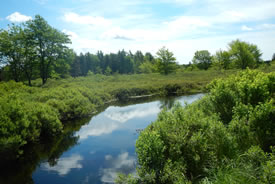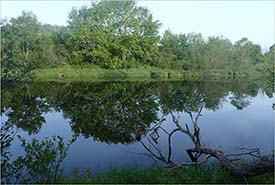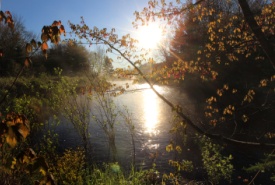Connecting the rivers for our future

Stehelin property, NS (Photo by NCC)
After three years of data collection covering 600,000 kilometres of rivers and streams, and collaboration between two countries and four provinces, Josh Noseworthy, director of conservation science at the Nature Conservancy of Canada’s (NCC) Atlantic Region, and his team have finally mapped a path forward to help conserve the freshwater rivers and streams of Eastern Canada. I recently interviewed Josh to learn more about this project.
Josh had always viewed Eastern Canada as a “conservation frontier.” Though many Canadian landscapes and wildlife have been studied extensively by conservationists and scientists, current scientific research is still filled with gaps — and this included the freshwater ecosystems of Eastern Canada.
“The wildlife living beneath our streams and rivers aren’t always easy to see and appreciate,” said Josh. “As a result, we often end up neglecting the importance of biodiversity in our freshwater ecosystems.”

Josh Noseworthy (Photo courtesy of Josh Noseworthy)
Leading a team of over 20 partners and international freshwater experts, NCC sought to fill this gap in the science with the support of multiple Canadian and U.S. funders. As a result, the ambitious Freshwater Conservation Blueprint project for the Northern Appalachian – Acadian region was born.
From southern Quebec to the eastern end of Nova Scotia, not much was known about the full network of freshwater rivers and streams and their associated watersheds. The blueprint covers not only four eastern Canadian provinces, but it also extends into the U.S., covering cross-border watersheds as far south as Vermont. In the U.S., these freshwater ecosystems had been classified and mapped, but the results stopped at the Canadian border. When it comes to understanding freshwater conservation issues and needs, the cross-border approach is important. Research collaborations in the past had been difficult to coordinate because each state and province was using different information.
Related content
“Rivers don’t stop at borders, and neither do fish and other aquatic wildlife,” said Josh. “That’s why it’s so important for everyone to be using the same information and to speak the same language to conserve our freshwater resources.”
Without good information on these freshwater systems, scientists were unable to identify the most important areas for biodiversity and the services that these freshwater ecosystems provide, such as reducing flooding and providing healthy drinking water.
And it’s not just scientists that appreciate these ecosystem services; they’re of value to everyone. In New York City, for example, conservation in the watersheds that filter the city’s drinking water has saved the city over $6 billion USD, compared to building and operating water filtration plants, according to the United States Environmental Protection Agency.

The Musquodoboit River, NS (Photo by Mike Dembeck)
Of course, to maintain these ecosystem services, streams and rivers need to remain healthy. To Josh’s team, understanding the plants and animals that live there is the perfect way to monitor the health of these aquatic ecosystems.
“Healthy populations of fish, insects and freshwater mussels indicate healthy streams and rivers,” said Josh. “They may not seem important in our everyday lives, but without them, we’re left paying enormous costs to compensate for the services that they provide for free.”
The Freshwater Conservation Blueprint project for the Northern Appalachian – Acadian region became a unique chance for NCC — and all participating scientists — to classify the streams and rivers of eastern Canada, which can be used to assess the different wildlife present. From here, scientists can monitor the health of streams and rivers based on their unique biodiversity. With this information, they can then prioritize which areas need the most help and formulate a suitable conservation plan.
Climate change is expected to impact many freshwater ecosystems, according to the Intergovernmental Panel on Climate Change. Josh is hopeful that his Freshwater Conservation Blueprint will provide accessible and reliable information about the rivers and streams of Eastern Canada to conservationists in order to protect and restore these valuable freshwater ecosystems for future generations. For the everyday science fanatic, Josh and his team’s research data can be accessed on an interactive map as well.

Tusket River, NS (Photo by Mike Dembeck)
In a way, this Freshwater Conservation Blueprint will provide a common language among scientists, conservation planners and municipalities across Eastern Canada and the U.S. As different provinces and states have different priorities and ways of doing conservation work, the Freshwater Conservation Blueprint presents an opportunity to produce a system that can unite everyone.
But Josh knows that this is only the first step, and his ambition for comprehensive freshwater research in Eastern Canada has only grown bigger. Exploring the terrestrial ecosystems that impact freshwater health, locating barriers to migrating fish, and prioritizing actions for species at risk in freshwater ecosystems are all on his work plan.
“I think the future is bright for these amazing freshwater ecosystems,” he says. “There are so many passionate people working to conserve freshwater biodiversity in this region.”
The Conservation Internship Program is funded in part by the Government of Canada's Summer Work Experience program.


